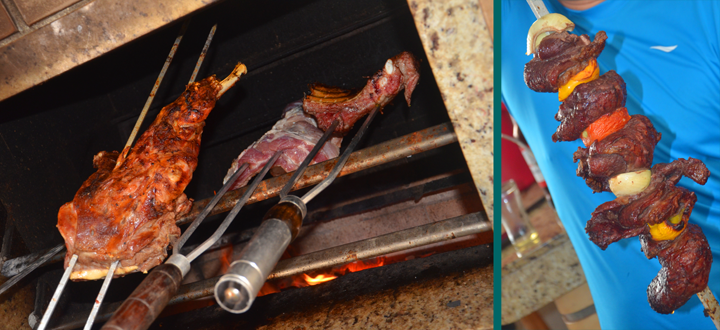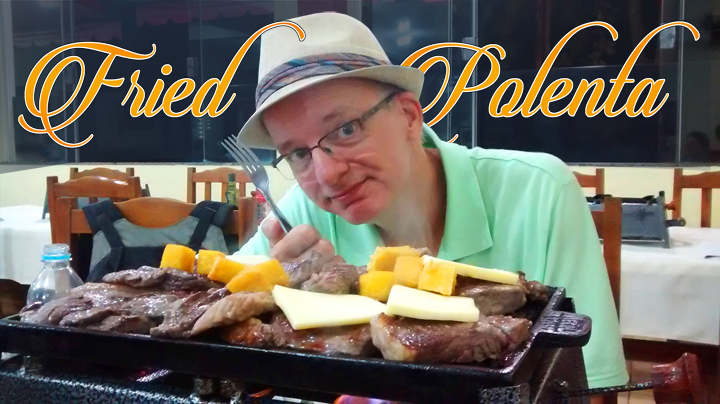Fried Polenta
I fear it would be very hard to be a
vegetarian in Brazil. Whenever I was taken out for a very special
meal, it was to a churrascaria, steakhouse barbeque. And, when
family gathered for any kind of celebration, it was the same kind of
meal. At restaurants and homes alike, huge slabs of ribs were cooked on
enormous skewers. Then, the meat was placed on the table pointing
straight up. It took three hands to cut it. One to steady
the skewer from the top, one to hold the knife and the last hand to grab
the sliced off piece with a fork.
On my final night in Brasil, we went to a different kind of churrascaria. At this one, the meat was cooked on the table with a double flamed grill. And, it wasn’t ribs. It was thick steak. As the meat cooked, you melted cheese on top of it. Absolutely everything tastes better with cheese.
I have never learned how to grill. I have a little one at my home. I’ve never opened the box. It remains in my garage, gathering dust, where I put it the day I bought it. I’m not even going to try to learn how to do that and describe it here. However, the meat was served with what I thought were golden fries. They were really golden. It was fried polenta, a popular side dish in southern Brasil.
Earlier this year, I mentioned sitting at the table for hours as a child as my father expected me to eat fried mush. It never happened. I still don’t know what mush is made of, but it was horrible. Mămăligă in Moldova, made from corn meal, reminded me of this. Well, fried polenta was even closer to that memory. Except, it was delicious. Come on, it looked like a very thick French fry! That has to be delicious! It definitely deserved research.
On my final night in Brasil, we went to a different kind of churrascaria. At this one, the meat was cooked on the table with a double flamed grill. And, it wasn’t ribs. It was thick steak. As the meat cooked, you melted cheese on top of it. Absolutely everything tastes better with cheese.
I have never learned how to grill. I have a little one at my home. I’ve never opened the box. It remains in my garage, gathering dust, where I put it the day I bought it. I’m not even going to try to learn how to do that and describe it here. However, the meat was served with what I thought were golden fries. They were really golden. It was fried polenta, a popular side dish in southern Brasil.
Earlier this year, I mentioned sitting at the table for hours as a child as my father expected me to eat fried mush. It never happened. I still don’t know what mush is made of, but it was horrible. Mămăligă in Moldova, made from corn meal, reminded me of this. Well, fried polenta was even closer to that memory. Except, it was delicious. Come on, it looked like a very thick French fry! That has to be delicious! It definitely deserved research.

Brasilian
Barbecue - Delicious at the restaurant or in you home
Fried
Polenta
Churrascaria, Barbosa Ferraz, Brasil
Churrascaria, Barbosa Ferraz, Brasil
Ingredients:
| 4 cups of water 1 tsp salt 1 cup cornmeal 2 Tbs butter |
1 Tbs olive oil per stick 3 Tbs Parmesan cheese 2 oz. soft goat cheese salt to taste |
Preparation:
Before you can fry up your polenta sticks, you have to prepare the polenta. You must allow several hours to do this, explained my friend Alisson. When you prepare polenta, it’s going to have the consistency of oatmeal. You then have to let it cool those several hours, let’s say at least four hours in the refrigerator, before it solidifies enough to cut it.
Bring the water to boil and add the salt. Gradually sift in the cornmeal and mix it with a whisk (if your kitchen has one. Mine doesn’t.) Lower the heat and cook the cornmeal for about fifteen minutes to let it thicken. Then turn off the heat and stir in the butter until it melts.
Oil an 9 by 12-inch baking dish and then transfer the hot polenta mix into it. Spread it all out evenly about an inch thick and then refrigerate it (four hours) until it is all cold and solid.
Cooking:
Preheat the oven to 250 degrees F (120 degrees C).
You want to cut the polenta into rectangles. It’s already 1 inch thick. You want the rectangles to be 1 inch by 2 inches. In a large skillet, over medium to medium-high heat, warm up the oil. You don’t want to overcrowd the frying space. Work in batches, frying up the polenta until it is golden brown. Plan on about three minutes per side.
Plan on a tablespoon of oil per stick. Okay, I said it’s delicious. I didn’t say it was healthy. You need enough oil to lightly cover the bottom of your non-stick frying pan. When the sticks are cooked, transfer them to paper towels to soak away some of that oily deliciousness. While you continue to cook up the rest of your polenta sticks, place the finished ones on a baking sheet in the oven to keep them warm.
You can garnish your polenta sticks with soft goat cheese, grated parmesan cheese, salt and pesto or marinara sauce. However, my polenta sticks were garnished with steak. I ate mine fresh off the grill and needed nothing else.
Meat:
| a few pig trotters a few pig ears and/or tails ½ lb salted pork ribs ½ lb. dried beef 1 lb. salt pork 1 lb. pork sausage |
1 lb Portuguese
sausage 1 lb Italian sausage 1 lb corned beef, cubed 1 lb smoked, lean ham hocks ½ lb pork loin ½ lb smoked bacon |
I looked at a few recipes. If you want to serve 8 to 10 people, use six pounds of meat. Serving a smaller amount of people, use less meat. When I had feijoada, my dish only had sausage, bacon, and pig skin. Yes, I said pig skin. I enjoyed the sausage. I love all bacon. But, I didn’t know what to do once I found it in my mouth. I wasn’t about to chew it, but I didn’t want to offend anyone either.
I swallowed it whole.
When you make your dish, I’ve provided all kinds of options for you to choose from. Nobody would use it all. Options. Options. Options. But honestly, I’m not recommending pig trotters, ears, or tails either.
Preparation:
Boil the salted meats for about 12 minutes. Next, do the same with the dried beef. Then, cut or slice all your meat into the size you want. Whatever you consider bite size works.
You’ll need a large soup pot to hold all this. Heat up the oil and then fry up your diced onions and garlic for a minute to get a light golden brown. The recipe calls for three cloves but you can never have too much garlic in your life or recipe.
Put your beans in the pot with two quarts of water. Toss in the bay leaves. Cut your orange in half, peel it, and add it to the mix. Then add the rest of your meat you decided upon. Cover it and simmer the goods for two hours until the beans are ready. Stir occasionally, add water as needed, and ladle off any oily scum that might find its way to the surface. Yuck!
Serving:
On every occasion that I saw feijoada served, it was with rice. Every cookbook called for a decorative addition of orange slices to the recipe. That sounds beautiful. I never saw it.
Other suggested goodies with your feijoada include cassava meal (called manioc in Brasil) with butter and eggs, collard greens, kale, and cachaça. Cachaça is the local distilled sugar cane juice. I wouldn’t recommend it with feijoada, coffee, or anything else. But, it is high on the list of Brasilians’ favorite alcoholic drink.
